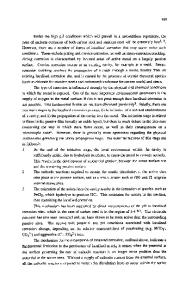Corrosion of Stainless Steel for HLW Containers Under Gamma Irradiation
- PDF / 272,095 Bytes
- 6 Pages / 414.72 x 648 pts Page_size
- 40 Downloads / 310 Views
CORROSION OF STAINLESS STEEL FOR HLW CONTAINERS UNDER GAMMA IRRADIATION
K. OSADA* and S. MURAOKA** *KUBOTA Corporation, 1-2-47, Shikitsuhigashi, Naniwa, Osaka, Japan "**JapanAtomic Energy Research Institute, Tokai, Ibaraki, Japan
ABSTRACT The corrosion behavior of type 304 stainless steel was studied under gamma irradiation as part of the evaluation for the long-term durability of high-level radioactive waste (HLW) disposal containers. Gamma rays, generated from fission products in high-level radioactive waste, are considered to change the environment around the canisters and overpacks. The redox potentials for NaCl solutions and corrosion potentials of stainless steel were measured to consider the effects of gamma irradiation, by using an electrochemical method. The pitting potentials of stainless steel for NaCl solutions were also measured to examine the pitting corrosion under gamma irradiation. As a result of this experiment, it is concluded that the oxidizing properties as a result of the formation of H2 0 2 and H2 produced by gamma irradiation depended on the concentration of Cl-, and that the strength of oxidizing 3 properties of 1M (mol'dm- ) NaCl solution was particularly high. And the pitting corrosion2 was found for 1M NaCI solution under gamma irradiation at the dose rate of 2.6x10 C/kg'h (1.0x10 6 R/h) at 60°C ,by using an electrochemical method. INTRODUCTION The corrosion behavior of type 304 stainless steel was studied under gamma irradiation to evaluate the long-term durability of high-level radioactive waste (HLW) disposal containers. The radiolysis of water is caused by gamma irradiation, therefore Ho, *OH, H2 0 2 , H2 and so on are produced, which are considered to affect the corrosion resistance of alloys. The alloy is considered to be corroded by contact with water, and the corrosion is accelerated in the presence of gamma rays[l]. The redox potentials for various concentrated NaCl solutions using a Pt-electrode as well as corrosion potentials of stainless steel were measured, to clarify the effects of gamma irradiation[2][3]. Cl- ion is considered to have the strongest effects on the pitting corrosion, so NaCI solutions were used for this experiment. The pitting potentials of stainless steel for NaCI solutions have been determined. EXPERIMENTAL The redox potentials for NaCI solutions and corrosion potentials of stainless steel for NaCI solutions were measured under gamma irradiation. The potentials were measured by the Automatic Polarization System HZ-1A, made by HOKUTO DENKO Corporation. This system includes mainly a potentiostat and a personal computer. Type 304 stainless steel was used as a candidate material for the canister. A platinum electrode was used to measure the redox potentials for NaCI solutions. Specimens of type 304 of 1cm x 1cm in size were used. The concentrations of NaCI were 1M (mol-dm'-), 0.5M, 0.1M and 0.01M. Cobalt-60 2 was used as a source of gamma rays at the dose rate of 2.6x10 C/kg-h (1.0x106 R/h) maximum at Japan Atomic Energy Research Institute (JAERI). This expe
Data Loading...











